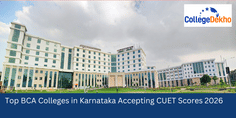
The difference between WB student credit card and bank loans must be understood by all students aspiring to get financial aid for their higher studies. Both are commendable ways to encourage students to continue their education without any monetary restraints, but the services offered in both these schemes vary. Banks are public or private entities while WBSCC is initiated by the West Bengal government.
The government of West Bengal launched the
West Bengal Student Credit Card (WBSCC)
scheme, which aims to provide students with hassle-free loans for higher studies. On the other hand, bank loans are accessible in many financial establishments but also often come with rigorous eligibility criteria, interest, and security requirements. Understanding the distinction between these two options helps students make informed decisions according to their financial needs, repayment abilities, and future academic ambitions. In this article, we will talk about the differences between WB student credit card and bank loans to help students opt for the best funding option.
Difference between WBSCC and Bank Loans
The table given below highlights the major differences between WB student credit card and bank loans:Feature | WB Student Credit Card (WBSCC) | Bank Loans |
|---|---|---|
Initiated By | Government of West Bengal | Public and private banks |
Purpose | Offers funding for higher education in India and overseas | Can be used for education-related purposes |
Loan Amount | Up to ₹10 lakh | Depends on the applicant (typically ₹4 lakh – ₹20 lakh or beyond) |
Eligibility | West Bengal domicile, currently enrolled in a WBSCC approved college in India or overseas | Indian citizens as defined by individual banks |
Repayment Period | Maximum 15 years, including repayment period | Generally between 10–15 years with a moratorium period |
Application Process | Online application through the government portal | They are a bit more involved and require more documentation because you will be applying through banks |
Processing Time | Faster approval process due to government support | Processing time is longer because of bank verification |
Government Subsidy | Yes, as lower interest rates and flexible repayment | There is no assistance from the government except for special schemes |
Flexibility | Tuition fees can also be used to pay coaching fees | Chiefly for tuition and associated expenses |
Collateral Required | No collateral required | Loans above ₹7.5 lakh will require collateral |
Also Read: West Bengal Student Credit Card Scheme vs Other State Student Loan Schemes
Pros and Cons of West Bengal Student Credit Card
To understand which is better for you, WBSCC or bank loan, it is necessary to know the pros and cons of both. Check the details of West Bengal Student Credit Card here:Pros of WBSCC
- Low interest rate: With a simple interest rate of 4% per year, it is more economical than educational bank loans.
- Not security intensive: Students do not need to pledge security by reducing the financial burden.
- High loan amount: An amount of up to 10 lakh is offered to students to cover tuition fees, housing, books, and other expenses.
- Flexible refund: Up to 15 years to repay, including a postponement period.
- Government Aid and Grants: These encourage access to education with minimal financial stress.
Cons of WBSCC
- Domicile: The WBSCC scheme is applicable only for students living in West Bengal for some years.
- Interest rate collection: Although the interest rate is low but it will grow after each period, resulting in an increasing repayment burden.
- Strict restrictions on loan usage: The money must be spent on educational expenses, not other individual needs.
- Sustainability: A parent/ guardian can serve as a Co-borrower, which may impact their credibility as well.
- Handling of delay: Some applicants have reported delays in approval and payment as a result of their own administrative procedures.
Pros and Cons of Bank Loans
Go through the merits and demerits of getting an education loan from a bank here:Pros of Bank Loans
- Easy access: Bank loans are easily available and offer high amounts (up to 20 lakh or more), especially in cases of students studying abroad.
- Open to all: These loans are open to students all over India without any limitation as per the state domicile.
- Hassle-free process: Applying for a bank loan for education is an easy method and many people are aware of the procedure in case you need any assistance.
- Customised borrowing options: Interest rates and refunds vary according to different state and private banking schemes.
Cons of Bank Loans
- High interest rates: Interests typically range from 8% to 14%, making refunds higher compared to WBSCC..
- Security Essential: Bank loans above 7.5 lakh are usually security based, increasing the financial risk.
- Cumbersome eligibility: Banks assess creditworthiness, income certificates, and the solidity of fellow applicants before granting you a loan.
- Repayment: All money loans have fixed repayment terms, but despite this, it can be difficult to cope in case of recession or a bad job market.
- Time-consuming approval process: Bank loans come with long documentation and approval processes, making it a longer process to access money.
Which is Better: WBSCC or a Bank Loan?
Students pursuing higher studies can opt for WBSCC for low-interest, security-less, long-duration (up to 15 years) repayment loans. It offers a particular 4 percent straightforward premium and also pays for assorted training costs, so it is a lower-cost option. Bank loans, on the other hand, have high volumes and high-interest rates (8%-14%) as well as stringent eligibility criteria and large loans that require security.
Thus, overall, WBSCC is a better option for West Bengal students who are looking for budget-friendly and hassle-free loans. However, people who need a bigger amount and across the country availability can opt for a bank loan if it is a better fit. They must always consider the repayment tenure and amount when finalising between WB student credit card and bank loans.
Also Read: Eligibility Criteria for West Bengal Student Credit Card
While the West Bengal Students' Credit Card (WBSCC) as well as Bank Loans allow students to finance their education, both differ in choice, interest, loan amount, and repayment stage. The payment plan structure that is best suited to a student is based upon the need for financing, the nature of course costs, along with repayment ability. Weighing both options carefully allows for better financial preparation for a successful education experience.
Related Links:
Stay tuned to CollegeDekho for more information about admissions in India. If you have further queries, you can call our toll free number 18005729877, or fill out our Common Application Form on the website.
Are you feeling lost and unsure about what career path to take after completing 12th standard?
Say goodbye to confusion and hello to a bright future!

FAQs
WB Student Credit Card: No security intensive.
Bank loan: A loan for loans above 7.5 lakh is often required.
WB Student Credit Card: Around 4% Simple interest rate (with a 1% license for female students).
Banking loans: Usually between 8% -15% based on bank and amount.
Students who are residents of the West Bengal have completed up to 40 years and class 10.
The WB student credit card is supported by the state government with easy repayment and low interest rate.
It is a government initiative from the Government in the West Bengal to provide educational loans of up to 10 lakhs of up to 10 lakhs to students engaged in higher education in India or abroad.
Was this article helpful?




















Similar Articles
Top 10 South Campus Colleges in Delhi University (DU): Courses Offered & Cutoff Trends
TG TET 2026: Exam Date (Out), Application Form, Hall Ticket, Syllabus
KARTET Hall Ticket 2025; Release Date, Steps to Download, Details Required, OMR Instructions
KARTET Paper 1 Syllabus 2025; Subject-wise breakdown with PDF
KARTET Paper 2 Syllabus 2025; Subject-wise syllabus with PDF
KSET Result 2025 Date and Time